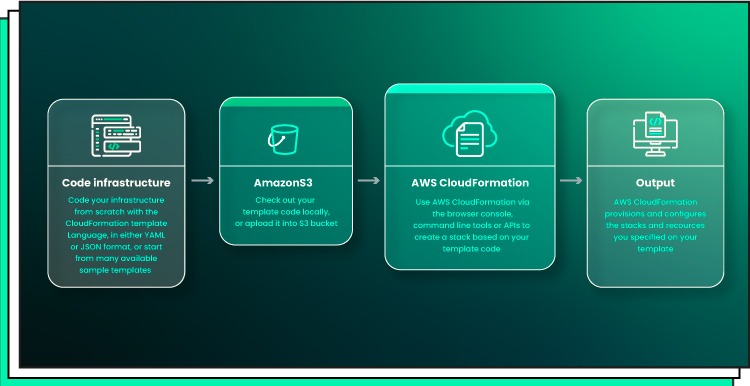Running a successful business requires seamless communication between its various departments and processes. Infrastructure management is no exception – it must be handled with precision and accuracy to ensure that hardware, software, and other resources are configured correctly. This can become increasingly difficult as more elements are added, like scaling existing applications to accommodate growing workloads.
Fortunately, Amazon Web Services (AWS) provides the perfect solution in the form of CloudFormation – an automated process that ensures smooth deployment and efficient maintenance of your company’s networks and other services.
In this blog post, we’ll discuss how CloudFormation helps streamline infrastructure management so you can focus on building great products instead of dealing with IT issues.
Introduction to AWS CloudFormation
AWS CloudFormation is a service that allows users to model and provision their entire cloud infrastructure using simple configuration files. It is an Infrastructure as Code (IaC) tool that makes it easier for developers and system administrators to manage their AWS resources by creating, updating, and deleting their infrastructure in a more automated way.
CloudFormation enables organizations to use a single language to model and provision their entire infrastructure across multiple regions and accounts. This automation helps reduce manual errors, improves resource utilization, increases system reliability, and reduces the time it takes to provision new environments.

Not only can AWS CloudFormation help with the deployment of resources, but it also helps with monitoring these resources over time. By managing related resources together as a single unit called “stack,” it provides visibility into what has been deployed, when changes are made, and where the deployments are running.
It also makes updating existing stacks easy. A user simply needs to update their template file, and CloudFormation will take care of the rest. Additionally, CloudFormation provides a robust set of features, such as stack policies that can help increase security by controlling who can change specific resources in your stack.

In addition, AWS CloudFormation also supports other services offered by AWS, such as Amazon EC2, Amazon SNS/SQS, Amazon RDS, etc., allowing users to integrate them into their deployment process for further automation. This integration allows users to benefit from all those services without having any prior knowledge or spending extra time learning them from scratch.
Benefits of CloudFormation
The benefits of using CloudFormation for infrastructure management are numerous. Let’s discuss the most obvious ones.
Improved Efficiency
CloudFormation is a powerful tool for creating complex stacks of resources quickly and easily, eliminating the need for manual configuration and deployment. This reduces the time it takes to spin up new services and applications, meaning developers and IT teams can focus their time on important tasks instead of manual setup.
Additionally, because CloudFormation templates are JSON or YAML files, they can be versioned in source control systems like Git or AWS CodeCommit. This allows teams to track changes over time and review deployments with greater detail.
Reduced Costs
By using CloudFormation to automate the creation of resources in bulk, organizations can benefit from significant cost savings. It also reduces the labor costs associated with manual configuration and deployment.
Also, because AWS charges only for the resources used when deploying a stack with CloudFormation, organizations don’t need to pay up-front costs associated with manual deployment processes. Finally, automation eliminates human error, which results not only in additional cost savings but also improved reliability.
Improved Scalability
Organizations can use CloudFormation templates to quickly scale up services as needed without having to manage each resource separately. This makes it easy for companies to adjust their usage according to changing demand, ensuring that customers have access to optimal performance levels without incurring extra development costs or operational overhead associated with manual scaling processes.
Efficient Resource Management
CloudFormation can be used to create and manage collections of related AWS resources in an automated and repeatable way. This helps ensure that all resources in a stack are configured consistently and reliably, with no manual intervention required. It also simplifies the process of making changes or adding new resources. Any desired modifications can be applied across multiple stacks simultaneously with just a few clicks.
Easy Deployment
CloudFormation provides an easy-to-use interface for users to monitor their stack’s status as it progresses through different stages. This includes being able to view changesets from previous deployments as well as apply tags to each resource at deployment time for better organization and tracking purposes. Furthermore, CloudFormation enables rollback capabilities so that any failed deployments can be rolled back to a known state quickly and easily.
Features of CloudFormation
The unique features of CloudFormation provide developers and system administrators with an easy way to create, configure, and manage their entire cloud infrastructure in an automated and organized manner. It uses templates to define the applications’ AWS resources needed for an application to run. These templates can be reused easily for multiple deployments, which helps increase efficiency and reduce mistakes caused by manual configuration. It also supports the orchestration of resources through a powerful set of APIs.
CloudFormation also provides version control capabilities, allowing users to keep track of changes made to their applications over time. This is useful for debugging purposes or simply keeping track of resource usage in order to optimize costs or meet compliance requirements.
Another advantageous feature offered by CloudFormation is its robust security model, which helps protect users’ data in transit between different services used within the application’s architecture. Finally, CloudFormation provides support for disaster recovery scenarios. It allows users to create backups of their application’s infrastructure so that they can quickly restore them after outages or other unexpected events occur.
Template Creation
CloudFormation templates are text files written in either YAML or JSON language, which define the infrastructure, such as compute instances, storage buckets, and databases. With these templates, users can create repeatable cloud deployments reliably and securely. Users can quickly spin up stacks of resources that follow best practices, including high-availability configurations and managed services.
Resource Provisioning
CloudFormation helps users provision resources with confidence by providing integrated version control for tracking changes over time. Moreover, AWS Identity and Access Management (IAM) capabilities help secure the deployment process by providing granular access control for each stack resource. This ensures that only approved personnel have access to critical business assets. It uses a declarative syntax to define what type of resources should be created and how they should be configured. This eliminates any manual steps required when setting up an application’s infrastructure and allows developers or system administrators to focus on more important tasks.
Change Management
CloudFormation enables users to easily manage their deployments across multiple accounts and regions with change sets. With change sets, users will have a preview of the changes they wish to make before actually deploying the changes, making it easy to identify potential issues early on in the process. Additionally, CloudFormation’s rollback feature allows users to quickly undo any undesired changes without deleting entire stacks of resources.
AWS CloudFormation Real-World Use Cases
CloudFormation has also become a powerful tool for many eCommerce companies such as Shopify Inc., an online store-building platform.
Shopify makes use of CloudFormation to create easy-to-use templates. These are used by customers to deploy complex infrastructures with just a few clicks or even automatically triggered by external events like changes on GitHub repositories or new releases pushed in production systems.
Netflix is a major streaming media provider which leverages CloudFormation for its platform development and deployment. Netflix uses the service to deploy its infrastructure stacks across multiple global regions in an automated way. Using CloudFormation, developers can quickly spin up or tear down servers, databases, and other components with practically no effort at all. This helps increase product consistency while keeping costs low.
Airbnb is another company that utilizes CloudFormation. Airbnb uses it to manage its massive infrastructure – for spinning up multiple layers of Amazon EC2 instances, setting up auto-scaling policies, allocating security groups, installing monitoring tools, and much more. This way, Airbnb can automate its deployments and keep track of changes in its infrastructures in an efficient manner.
Capital One employs CloudFormation in its DevOps environment. It uses CloudFormations scripts to orchestrate deployments across multiple AWS accounts while ensuring a stable architecture across all environments (dev/test/production). This helps the team maintain consistency in multiple environments while avoiding manual configuration errors. Capital One also makes use of robust security features offered by CloudFormations, such as allowing access control lists or controlling API access on AWS resources.
Expedia Inc., one of the world’s leading online travel booking companies, also utilizes CloudFormation. Expedia creates a custom template library for its cloud environments using CloudFormation, which allows them to quickly deploy reliable infrastructures for their applications and services with less risk of errors or downtime.
CloudFormation Best Practices
There are a few practical tips and best practices to keep in mind when using CloudFormation that will help you maximize its efficiency and get the most out of it:
Keep your template files organized
When working with multiple templates, it’s crucial to organize them so they are easier to maintain and update over time. Consider naming conventions, folder structures, version control systems (such as Git), and other methods for organizing your template files.
Utilize reusable components
To save time and effort when creating CloudFormation templates, consider breaking them into smaller parts that can be reused in different stacks or other templates. This way, you won’t have to rewrite code each time you create a similar stack or need to make changes later.
Leverage parameterization
Whenever possible, use parameters instead of hard-coding values into your template so that you can easily customize values with every deployment without having to go back and edit the template itself. Parameters also make it easier for someone else who might be unfamiliar with the resource being created or managing the stack to understand what is going on in the template. By using parameters, the person will not have to dig through all of the code.
Use intrinsic functions
CloudFormation provides many built-in functions, which allow users to perform certain operations without explicitly writing out code themselves. For example, by using conditional functions like Fn::If in combination with parameters, users can create more dynamic templates that respond better to different environments or configurations without having to modify each parameter value as needed manually.
Take advantage of automation tools
To streamline deployments even further, there are various automation tools available, such as AWS Cloud Development Kit (AWS CDK). They allow users to write custom code in programming languages such as JavaScript or TypeScript while still taking advantage of CloudFormation’s underlying infrastructure capabilities, including automated rollbacks and change sets.
Designing a CloudFormation Template
Now, let us lead you through the process of designing a CloudFormation template.
Think about the overall structure of the template first. Create a logical structure by using resource nesting capabilities offered by CloudFormation. This will help ensure that changes are isolated and repeatable, making it easier to debug any issues or update template components as needed.
It’s also beneficial to break up complex templates into smaller manageable chunks with StackSets, which allows you to deploy an identical set of resources across multiple accounts or regions simultaneously. Additionally, consider taking advantage of the YAML format when authoring your templates, as the readability can make debugging easier and reduce errors when writing complicated templates.
Using version control makes managing changes across multiple teams easy while simultaneously enabling rollback capabilities in case something goes wrong. To utilize version control with CloudFormation, create branches for major versions so different teams can work on larger projects simultaneously.
Besides, consider setting up continuous integration/delivery pipelines that automatically run tests against any changes being proposed before deploying them into production environments. This will help ensure the integrity of any configuration changes made with CloudFormation and reduce human error due to manual testing requirements.
Final Word
Automation with AWS CloudFormation can help you quickly deploy cloud infrastructure and applications without putting confidential information at risk. Organizations that make use of this powerful cloud computing tool are much better placed to maximize their digital transformation outcomes in terms of both scalability and efficiency.
If your organization is looking for a reliable partner in their transformation efforts, reach out to Forbytes. From understanding the basics of CloudFormation to helping create complex automated solutions, our experienced professionals are fully capable of leveraging the power of automation for your business needs.

Our Engineers
Can Help
Are you ready to discover all benefits of running a business in the digital era?

Our Engineers
Can Help
Are you ready to discover all benefits of running a business in the digital era?







